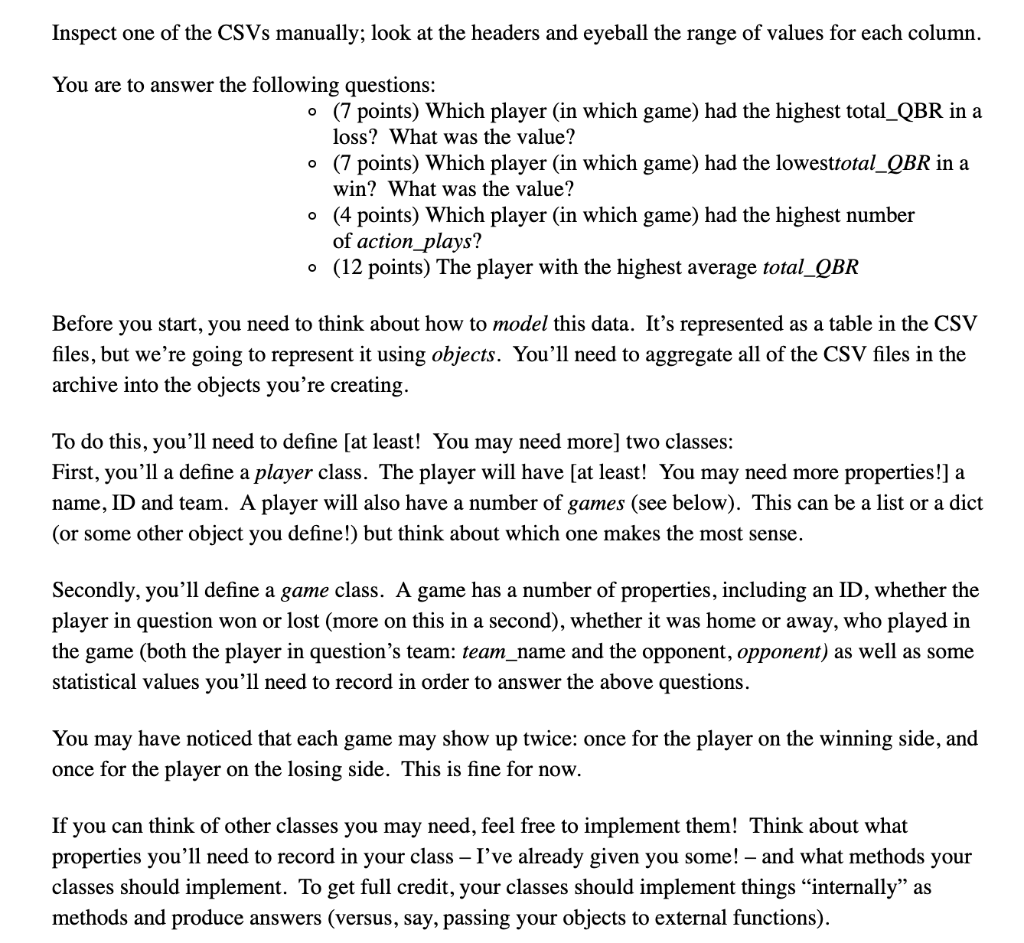Python Code
Inspect one of the CSVs manually; look at the headers and eyeball the range of values for each column You are to answer the following questions o (7 points) Which player (in which game) had the highest total QBR in a o (7 points) Which player (in which game) had the lowesttotal_QBR in a o (4 points) Which player (in which game) had the highest number o (12 points) The player with the highest average total QBk loss? What was the value? win? What was the value? of action_plays? Before you start, you need to think about how to model this data. It's represented as a table in the CSV files, but we're going to represent it using objects. You'll need to aggregate all of the CSV files in the archive into the objects you're creating To do this, you'll need to define [at least! You may need more] two classe First, you'll a define a player class. The player will have [at least! You may need more properties!] a name, ID and team. A player will also have a number of games (see below). This can be a list or a dict (or some other object you define!) but think about which one makes the most sense. Secondly, you'll define a game class. A game has a number of properties, including an ID, whether the player in question won or lost (more on this in a second), whether it was home or away, who played in the game (both the player in question's team: team_name and the opponent, opponent) as well as some statistical values you'll need to record in order to answer the above questions You may have noticed that each game may show up twice: once for the player on the winning side, and once for the player on the losing side. This is fine for now If you can think of other classes you may need, feel free to implement them! Think about what properties you'll need to record in your class - I've already given you some! - and what methods your classes should implement. To get full credit, your classes should implement things "internally" as methods and produce answers (versus, say, passing your objects to external functions) Inspect one of the CSVs manually; look at the headers and eyeball the range of values for each column You are to answer the following questions o (7 points) Which player (in which game) had the highest total QBR in a o (7 points) Which player (in which game) had the lowesttotal_QBR in a o (4 points) Which player (in which game) had the highest number o (12 points) The player with the highest average total QBk loss? What was the value? win? What was the value? of action_plays? Before you start, you need to think about how to model this data. It's represented as a table in the CSV files, but we're going to represent it using objects. You'll need to aggregate all of the CSV files in the archive into the objects you're creating To do this, you'll need to define [at least! You may need more] two classe First, you'll a define a player class. The player will have [at least! You may need more properties!] a name, ID and team. A player will also have a number of games (see below). This can be a list or a dict (or some other object you define!) but think about which one makes the most sense. Secondly, you'll define a game class. A game has a number of properties, including an ID, whether the player in question won or lost (more on this in a second), whether it was home or away, who played in the game (both the player in question's team: team_name and the opponent, opponent) as well as some statistical values you'll need to record in order to answer the above questions You may have noticed that each game may show up twice: once for the player on the winning side, and once for the player on the losing side. This is fine for now If you can think of other classes you may need, feel free to implement them! Think about what properties you'll need to record in your class - I've already given you some! - and what methods your classes should implement. To get full credit, your classes should implement things "internally" as methods and produce answers (versus, say, passing your objects to external functions)







